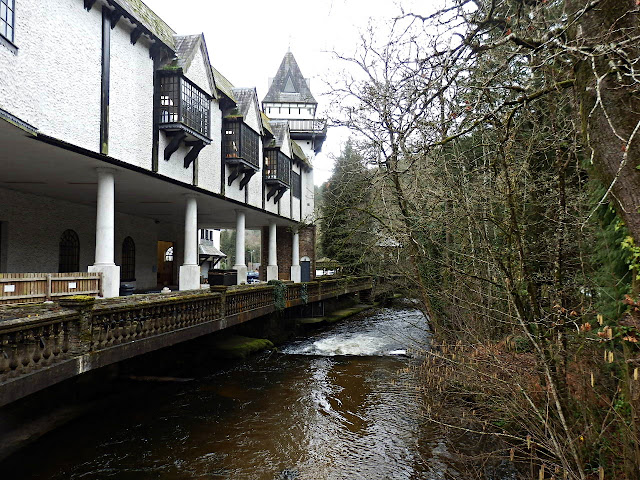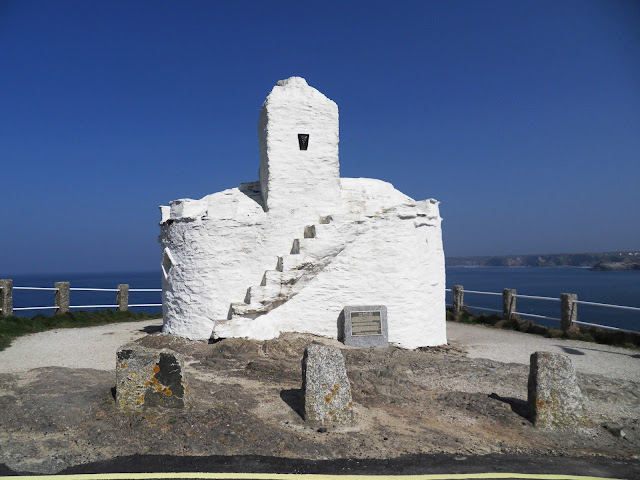Sunday 10 March 2019
Beyond The Beacon Near Du Maurier's Manderley / Menabilly
Briefly following on from yesterday's post, which mentioned Daphne du Maurier's book Rebecca.
Here's a passage from the book, which could well be the scene in the photo above :
"And I thought of the tide, how swift it ran and strong into the little cove. The wind blew down from the headland like a funnel. I got the boat out into the bay. I got her out there beyond the beacon ..."
~ Quote from Rebecca by Daphne du Maurier
The beacon can be seen in the photo and this is adjacent to Manderley / Menabilly - as mentioned yesterday.
Saturday 9 March 2019
The Wonderful Coastline At Menabilly - Daphne du Maurier Country
A few photos of a walk along the coast path from Menabilly on Cornwall's south coast.
The author Daphne du Maurier lived at the estate house here from 1943 to 1969. Unfortunately the house is hidden away from the beach and coastal path
Menabilly was Du Maurier's inspiration for Manderley in her book Rebecca. The first sentence of the book reads : Last night I dreamt I went to Manderley again.
The sentence is almost like a cry from herself. At the time her husband had been temporarily posted to Alexandria, which she disliked. She longed to return to Menabilly, her Manderley, and to see the cliffs, sea and the wooded headlands. And who can blame her!
I did manage to dig out a very old photo - below - of the author at Menabilly with her children - though the quality isn't very good.
The Menabilly estate extends along one side of the coastal path.
The day we walked along the coast path it was quite hazy in the distance, as can be seen from the photos. The photo above and below shows where the River Fowey joins the sea.
Lots of ups and downs, of course, along the path but such wonderful views, especially on a clear day.
Retracing our footsteps the sun brightened up the day - and even the cows came out to play!
It's a lovely stretch of coast to walk.
See also:
Daphne Du Maurier Featured On Large Cornish Mural
Friday 8 March 2019
From Charitable Daffodils to Loot and Extortion
Just a few days ago life seemed to be all daffodils and blue sky. The arc of daffs in the phot0 were planted originally on behalf of the Marie Curie charity who offer care and support through terminal illness. Their symbol being the daffodil.
At the time of writing though it's now grey and raining - and I have a job to do - decorate our living room! So we headed off to Trago Mills Liskeard branch to buy paint and wallpaper.
They are housed in quite an unusual store, it's more like a big castle, with its own river, than a massive shopping centre.
Of course, when we arrived it was raining! So not many photos.
Over the years the original Trago owner, and now his son, have had clashes with authority. Their tongue in cheek response is to erect statues in their large grounds to make their opinions known. There are dozens of them.
For example the photo below is an opinion of UK's taxes - loot and extortion.
Another statue, below, is making a point about pillaging and plundering - now who would do such a thing ...
And finally a photo of the river and the store.
Oh dear decorating - what fun!
Thursday 7 March 2019
Newquay, Cornwall - Wonderful Beaches, Stunning Views
A while back, when I snapped these photos, we had lunch at the Fort Inn, Newquay. The first three photos were taken from the Inn where there are stunning views.
The photo above is looking right - along the popular Towan Beach. Not too many people about out of season.
The photo above is the Fort Inn's terrace and the photo below is Newquay Harbour looking left from the terrace.
After lunch we headed back towards the main centre at Newquay. Towan Island (below) always fascinates me. The only access to the house is over the slender bridge. The island is surrounded by water when the tide is in.
And finally looking back in the direction of the Fort Inn.
Newquay, with it's wonderful beaches, gets very busy in the summer season - several good surfing beaches. It has been voted as "one of the nation's favourite seaside towns."
Also see: The Hue and Cry Made From A Huers Hut At Newquay, Cornwall
Wednesday 6 March 2019
The Hue and Cry Made From A Huers Hut At Newquay, Cornwall
The photos are of a Huers Hut overlooking the sea at Newquay, Cornwall. It is said to date from the 14th century - but could well be older - and was used as a look-out when shoals of pilchards were expected in the bay.
The huer would sound his horn raising a hue and cry alerting townsfolk to the arrival of the fish.
By means of hand signals the huer enabled the fishermen to position their boats and encircle the shoals into their nets.
Previous to being used by a Huer the hut may have been a hermitage. Externally the building has a large, typically Cornish, late medieval chimney and a narrow stairway leading to the roof.
Though I have used the words hue and cry above there are other suggestions as to how the phrase originated. Wikipedia, for example, suggests the following:
By the Statute of Winchester of 1285 it was provided that anyone, either a constable or a private citizen, who witnessed a crime shall make hue and cry, and that the hue and cry must be kept up against the fleeing criminal from town to town and from county to county, until the felon is apprehended.
See also : Newquay Harbour in 1875 and 2019
Tuesday 5 March 2019
Daphne Du Maurier Featured On Large Cornish Mural
The author Daphne Du Maurier features on a mural in St.Austell. Many of her books are set locally in Cornwall - such as Jamaica Inn, Rebecca, The House on the Strand and so on.
The mural, by Janet Shearer, depicts well known people (at least well known to local residents!) who live or lived near to St.Austell - one of these being Daphne Du Maurier. She is in the premier position, the lady at the top of the art work looking over a balcony.
The mural is a reproduction, four times the size of an original painting. This was photographed and then scaled up and printed on aluminium sheets which were then affixed to the building.
Amongst the diners at the fictional 'China Cafe' are Nigel Martyn (Former England Goalkeeper), Jemma Simpson (Olympic Athlete), Richard Sharp (England Rugby Player), Beatrice Rogers (First Female Deaconess in the Methodist Church), AL Rowse (Historian and Poet), Walter Hicks (Founder of St Austell Brewery), Silvanus Trevail (Architect), William Cookworthy (Discoverer of China Clay in Cornwall), John Nettles (Actor), Bishop Colenso (First Anglican Bishop of Natal), Captain Percy Phillips (Founder of the Cornwall Aviation Company) and Jack Clemo (Writer and Poet).
Monday 4 March 2019
Polkerris The Fortified Cove, Cornwall
Polkerris cove, Cornwall, is quietly tucked away from the hectic world down a very narrow lane. The village itself is small but has the advantage of having the Rashleigh Inn right on the beach - a perfect place to watch the sun go down.
The photo above was taken from the cliff top coastal path.
The name Polkerris is a bit of a puzzle. History shows it was once known as Polkeryes. It is believed that the first part of the name may have originated as 'Porth' meaning harbour or haven in the Cornish language. Later the second part of the name became 'kerris' meaning to fortify or enclose - which ties in with the photo below.
Yes canons, and they are embedded in the harbour wall - part of the fortifications perhaps. It is thought that they are from the Napoleonic era.
During the 18th century the harbour was developed for pilchard fishing. A quay was constructed around 1735, together with fish curing cellars.
Nowadays Polkerris is a popular place for visitors to enjoy the small beach, rock pools, watersports and the spectacular views across St.Austell Bay.
The Inn on the beach has a range of food and drinks.
Subscribe to:
Posts (Atom)
FEATURED POST
A Day in Cornwall: Charlestown, St.Austell, Heligan
A few photos from the last week when we were out and about. Above is the port at Charlestown and below is looking out to sea from the harbo...






























